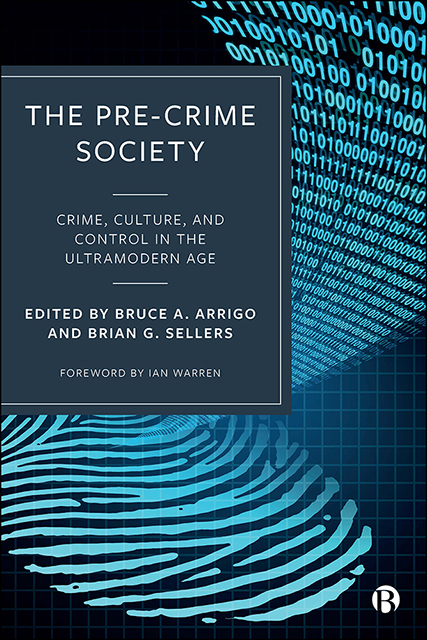Book contents
- Frontmatter
- Dedication
- Contents
- Notes on Contributors
- Foreword
- Introduction: The Ultramodern Age of Criminology, Control Societies and ‘Dividual’ Justice Policy
- Part I Theories, Theorists and Theoretical Perspectives
- Part II Institutions, Organizations and the Surveillance Industrial Complex
- Part III Dataveillance, Governance and Policing Control Societies
- Part IV Systems of Surveillance, Discipline and the New Penology
- Part V Globalizing Surveillance, Human Rights and (In)Security
- Afterword: ‘Pre-Crime’ Technologies and the Myth of Race Neutrality
- Index
15 - Towards Predictivity? Immediacy and Imminence in the Electronic Monitoring of Offenders
Published online by Cambridge University Press: 14 April 2023
- Frontmatter
- Dedication
- Contents
- Notes on Contributors
- Foreword
- Introduction: The Ultramodern Age of Criminology, Control Societies and ‘Dividual’ Justice Policy
- Part I Theories, Theorists and Theoretical Perspectives
- Part II Institutions, Organizations and the Surveillance Industrial Complex
- Part III Dataveillance, Governance and Policing Control Societies
- Part IV Systems of Surveillance, Discipline and the New Penology
- Part V Globalizing Surveillance, Human Rights and (In)Security
- Afterword: ‘Pre-Crime’ Technologies and the Myth of Race Neutrality
- Index
Summary
Introduction
‘Electronic monitoring (EM)’ is a form of ‘coercive connectivity’, a generic term for a range of correctional technologies which utilize networked communication systems and body-worn sensors (‘tags’—usually on ankles, sometimes wrists) to pinpoint and track the locations and movements of defendants and offenders. They are used by judicial and penal authorities to monitor real-time compliance with supervisory regimes of varying restrictiveness and duration, at the pretrial, sentencing and post-release stages of the criminal justice process. More recently, immigration authorities in some countries, notably the US, have adopted location monitoring, using the same rationale—they are an ostensibly cheaper form of control than imprisonment and detention, albeit with distinct restrictions and ‘pains’ of their own. Although short range radio frequency (RF) detection systems for enforcing home confinement (the original judicial form of EM), still exist, Global Positioning System (GPS) satellites, ostensibly for tracking movement, and enforcing inclusion/exclusion zone boundaries (including house arrest), have become dominant. Biometric voice verification of identity and location simultaneously (which unlike RF and GPS does not require a wearable device, just a phone) has been relatively little used. Remote alcohol monitoring technologies—wearable or portable devices connected to communication networks, used to enforce or regulate court-ordered sobriety—have expanded the definition of EM beyond mere location monitoring. What all existing forms of EM have enabled in community corrections and law enforcement is ‘immediacy’—a capacity to know, or verify, an offender's location remotely in real-time, which made new forms of compliance, control and containment possible.
The forms in which EM has developed since the 1980s, and the discourses surrounding it, have always reflected wider developments in what was until quite recently called ‘information and communication technology’, but is now more usually glossed as ‘networked connectivity’ (Nellis, 2018). The companies and corporations that have manufactured, sold and rented EM to state agencies have, by and large, customized pre-existing technologies for penal markets rather than inventing anything new, which is not to deny the engineering ingenuity required to build small, compact and secure/non-removable wearable devices. RF EM utilized a 1940s ‘object identification’ technology that had gradually become part of a wider RFID (Radio Frequency Identification) movement to revolutionize logistics, stock control and complex supply chains by attaching a ‘tag’, or inserting a ‘chip’ into any stored or moving object—package in transit, consumer product, vehicle, container.
- Type
- Chapter
- Information
- The Pre-Crime SocietyCrime, Culture and Control in the Ultramodern Age, pp. 341 - 364Publisher: Bristol University PressPrint publication year: 2021

